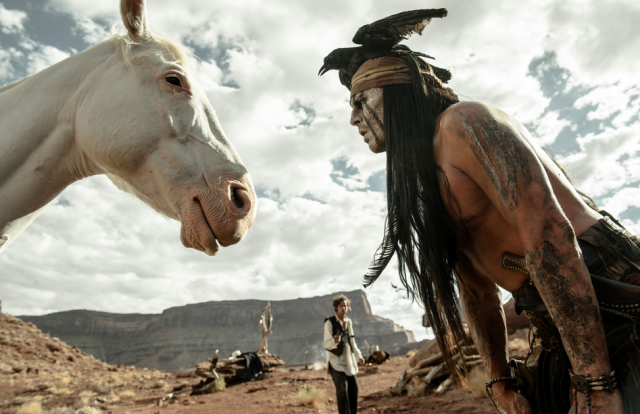Thanks to Halloween, outdoor music festivals and the college Greek system having access to social media, people of color are constantly bombarded with acts of cultural appropriation, but with the help of rich and ignorant celebrities, 2013 had to be cultural appropriations’ most visible year yet! So, to those who attempt to add an entire race’s marginalized dress, dance or religious adornments to their own personal walk-in closets for the sake of ‘fashion’ and more importantly, to all the people of color/allies who haven’t been able to enjoy a moment’s peace on Facebook or YouTube this year without having to shout ‘REALLY?!” at your computer screens (be sure you have a pillow to scream into handy), I bring you my Top Ten Instances of Open and Unapologetic Celebrity Cultural Appropriation in 2013!
10. Selena Gomez Refuses to Research the Backstory of the Bindi
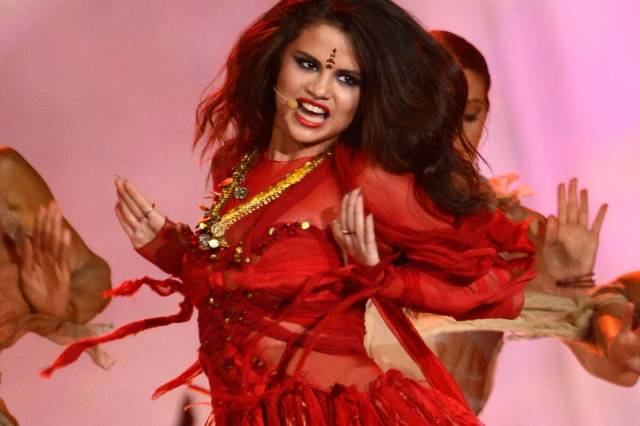
When pop singer, Spring Breaker and former Wizard of Waverly Place, Selena Gomez decided her newest boring pop song, “Come and Get It” had an “Hindu, tribal feel,” she thought the best way to celebrate that assertion would be to debut the song with some half-assed Bollywood-style choreography and unceremoniously donning a bindi (a traditional Hindu adornment representing the sixth chakra) on her forehead at the MTV Music Awards. In a pissed off statement released by Rajan Zed, President of the Universal Society of Hinduism:
“The bindi on the forehead is an ancient tradition in Hinduism and has religious significance…[it] was not meant to be thrown around loosely for seductive effects as a fashion accessory aiming at mercantile greed.”
Regardless of the backlash of more informed people, Selena not only continued to wear a bindi at several other events, she also made some really stupid statements in her defense of doing so, such as this great excuse she said aloud to US Weekly, “My hairstylist and my makeup artist are actually really big into the whole culture — they’ve been around, they’ve traveled, they’ve gotten me into various books.”
While I’m sure the fact you did the world’s laziest research is really appreciated by the Hindu community, ultimately, you’re not going to teach Hindus about the history and appropriate use of their own cultural and spiritual creation. Also, the fact that other, whiter artists with a richer history of cultural appropriation have done the same thing (i.e. Madonna, Gwen Stefani) is less of an excuse and should be more of a lesson. When you decide to appropriate a symbol of a culture you’re not a part of because of a pop song that you’ve described as “Hindu,” “tribal” AND “Middle Eastern,” you don’t know what you’re talking about. Stop defending your dumbass mistakes, learn your lesson gracefully, and take off the fucking bindhi. You’re embarrassing yourself.
9. Michelle Williams Dons Redface For Fashion
In March of 2013, actress Michelle Williams was featured in a photo spread with British fashion magazine, AnOther to promote her then opening film, Oz the Great and Powerful. The photos were described by the magazine as Michelle “transforms into eight imaginary characters.” I may not know anything about fashion or fashion shoots or what the hell magazine this is, but all the photos seem par for the course of this stuff. The ‘characters’ consist of mostly rich looking white ladies, along with one picture of a dressed down Williams in overalls and little makeup, aka a poor looking white lady. Then you come across this picture:
It doesn’t take a fashion designer or textile major to recognize this is straight up REDFACE. What makes this style choice even more disturbing, other than the fact that several editors, photographers, stylists, and the actress herself signed off on it, is the theme of the shoot is “imaginary characters.” Sure, the editor/photographer most likely meant ‘imaginary’ in the way that Michelle Williams is not really the owner of that satin Armani jacket and she wouldn’t really wear a brown wig with some Dior tulle, I guess, but what can’t be separated from this image is the juxtaposition of a white American woman, dressed as an ‘imaginary’ Native ‘character’ just for fun, and the oppressive history of Native people being portrayed as mythical and historically extinct figures in America. As ‘ethereal’ and ‘imaginary’ as you want this image to be, accessories and soft lighting cannot erase the bloody history of colonization and the continuing misrepresentation, or complete lack thereof, of Indigenous people in mainstream media. Turns out like blackface, redface is NEVER OKAY…unless the theme of your photo shoot is ‘Gross-ass Acts of Celebrity Cultural Appropriation.’ Come on, girl. You know better.
8. Iggy Azalea’s ‘Bollywood’ “Bounce”
I don’t want to spend too much time on this, but I have to say, I’m sort of astounded at the sheer meta-level of cultural appropriation here. A white, Australian rapper creating an Indian-themed music video for an American hip-hop single? Whoa. There is obviously nothing wrong with non-Indians enjoying Indian Bollywood films and Indian culture. What becomes problematic is the meshing of several elements of actual Indian culture and stereotypical Indian culture, and the presentation of this culture as a ‘fashion trend.’ The video itself is all over the place as far as the ‘Indian theme’ is concerned. One minute there is a Holi celebration, then a Bollywood-inspired large scale choreographed dance number, then Azalea is riding through a city atop an elephant, possibly inaccurately evoking her misinformed view of Hindu deity Ganesha/Ganesh, who she apparently assumes is a female elephant goddess?”
I think blogger Julie Gerstein of The Frisky said it best with, “personally I’m super over artists appropriating other cultures like they’re just another fashion trend. Not cute.” WERD. Rampant cultural appropriation aside, yet another egregious offense committed by this video is simply this song is FUCKING TERRIBLE.
7. Ireland Baldwin Tweets Her ‘Native American’ Halloween Costume

Ireland Baldwin, the 18 year-old daughter of actor and possible homophobe Alec Baldwin and ex-wife, actress Kim Basigner, decided to share some pictures of her upcoming Halloween costume with her many Twitter followers (who I assume also follow Melanie Griffith and Don Johnson‘s daughter, Dakota). Unfortunately for Ireland, Indigenous people, and anyone who had hope for the millennial generation of celebrity children, the “costume” was actually a stereotypical shoddy “Native American headdress” complete with added lipstick “war paint” on her face. Not too surprisingly, Twitter rightly blew up with cries of racism and cultural appropriation. From there, Ireland took a page out of her dad’s book of random aggressive defensive rants and tweeted she removed the picture “because it was insulting all the poor little white girls who need a racial cause to be a part of for attention.” I’m glad someone finally took those white girls to task. Their constant cries of racial causes are seriously one of the last obstacles in ending racism.
In more terrible attempts at defending her shitty behavior, Ireland invoked the classic white person derailment tactic of claiming Cherokee ancestry, a favorite default of non-Natives accused of racism or cultural appropriation perpetuated against Native people. Because everyone knows that distant ancestry you’re most likely aware of due to word of mouth OBVIOUSLY ingrains a person with a deep, spiritual connection and personal understanding of what it’s like to live in America as that minority. Possibly the best defense of the costume was when Ireland tweeted a picture of the “Big Chief” character from Disney’s Peter Pan, claiming her intent wasn’t to portray just any random Native person, but a specific one for a trip to Disneyland!
Oh, wait, so you’re not dressing in a mass-produced stereotypical ‘Native’ costume, and instead were just dressing as one of the most racist caricatures depicting an Indigenous person in the history of American cinema? Nevermind, you’re right, the outfit is fine.
6. Lilly Allen’s Attempt at Sexist Satire Backfires
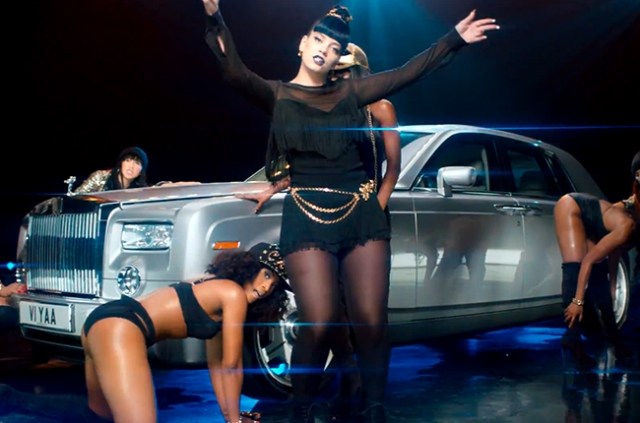
As our televisions became inundated with images of Miley Cyrus, making questionably hygienic decisions such as licking hammers or touching Robin Thicke (singer of 2013’s summer rape anthem, “Blurred Lines”), and the pop music scene as a whole continued spewing out another year of marketing the objectification of women and promoting male artist anthems beckoning consumers to find power in the patriarchy, British pop singer Lily Allen decided she’d had enough and attempted to pen a protest song to combat pop music’s sexist standard. The result, “Hard Out Here, ” (the title and chorus of which is a parody of Oscar-winning tune, “It’s Hard Out Here for a Pimp”) intends to take the sexist music industry to task, but often goes off topic, such as right out of the gate, condescending the alleged materialistic nature of hip-hop and rap music with lyrics like, “I won’t be bragging ’bout my cars or talking ’bout my chains.”
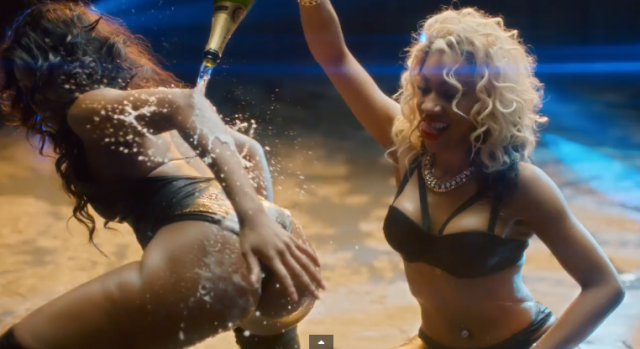
That aside, the real problematic element of the song became the accompanying music video where the supposed parody and satire seemingly lose their intelligence. Allen is flanked by several black female dancers, and while she herself is presented as dominant and remains fully covered, the dancers sport tiny bathing suits as they twerk, kneel and bow on all fours around her. One could argue there exists inherent parody within these images which are possibly aimed at satirizing what many have perceived as Miley Cyrus’ objectification of the black female body, but as champagne is poured down the dancer’s backsides, and Allen giggles as she slaps their asses, all while performing a song with lyrics like, “don’t need to shake my ass for you ’cause I’ve got a brain,” it’s hard to tell if she’s on the right side of the parody or not. After receiving some backlash in response to the video, Allen later apologized and reasoned that she didn’t intend the video to be “about race,” which further proves she wasn’t in on the right joke. While Miley Cyrus seems to be using black culture and dance as a form of sexual accreditation, Lily Allen is saying she’s smarter and above it. This song could have been a great anthem of solidarity against sexism, but sadly instead did what the feminist movement has been guilty of for decades…leaving women of color out of the conversation.
5. Dear Miley Cyrus: It’s Just Not Twerking
By far, the most talked about celebrity campaign of cultural insensitivity this year was the oblivious cultural appropriation parade headed by pop singer and Billy Ray Cyrus seed, Miley Cyrus. Between her famed teddy bear, twerking, foam finger party at the VMAs and her subsequent art installation about emotionally melodramatic relationships, many journalists and bloggers criticized her new found “sexuality” by taking issue with her choices to wear underwear like pants or swinging around naked on construction equipment (hello UTI). The major issue here is not the misinformed “empowerment” of her perceived sexuality. Between using black female dancers as props and her seemingly relentless crusade in the past year to be crowned the Queen of Twerk (a dance she didn’t create nor can she even execute correctly), Miley is attempting to adopt black female sexuality as an accessory while having the privilege of avoiding the racist negatives that go along with it. The very dance Miley is using to elevate her new sexualized image has been used to condemn, criticize and condescend black women when used as a codifier of behaving ‘poor’ or ‘ghetto.’ This isn’t to say white people can’t twerk, but there are ways to enjoy and celebrate another culture’s dance without doing this:
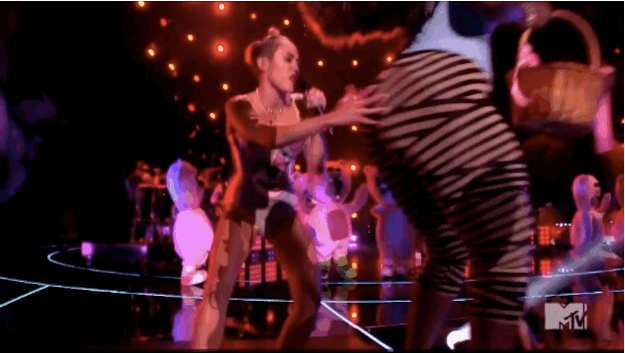
Another glaring issue with Miley’s attempts at being the spokesperson for this dance is SHE ISN’T EVEN DOING IT RIGHT. Twerking IS NOT just bending over and shaking your ass. If you want to see some real twerking in action for the crazy amazing athletic feat it is, check out the Twerkers Gone Wild YouTube series by Caramel Kitten, in which she twerks by the fish at Walmart and silently twerks in the library.
4. Katy Perry’s Asian Appropriation at the AMAs

Let me just start this one with uuuuuuuuuuuuuuuuugggggggggghhhhhh. Pop singer, preacher’s daughter and person who once said she was so “obsessed with Japanese people” she wanted to “skin” them and “wear” them “like Versace,” Katy Perry, performed at the American Music Awards this year in what has been described by the media as both an “Asian themed” and “geisha inspired,” performance of some song of hers called “Unconditionally.” Wearing a dress that was a more cleavage-baring knockoff of both a Japanese kimono and a Chinese cheongsam, bowing and flitting about onstage amongst cherry blossoms, dancers with parasols and large fans, and some guys hitting a wadaiko, Perry appeared to present what Kotaku referred to as a “Pan Asian buffet” of images and cultural references.
While many media outlets described this cultural hodgepodge as “beautiful,” I think we need to call it what it really is: hardcore cultural appropriation (with an open possibility of just being straight up racist). I’m sure Perry will at some point release an insincere statement about how the performance was meant to honor all Asian culture (although she missed some countries), because she finds them so “beautiful” and some other comment where she’ll basically refer to Asian history and customs as her own personal fantasy. Turns out Japan and China are not fantasy lands, they are real countries, with real histories and real people who are fully capable of being the spokesperson of their own cultures. Also, Japan and China are not the same country. Meshing their completely separate cultures together is a common racist view by Western society which Katy Perry chose to continue to espouse to the world as a whole at a televised event.
3. Miley Cyrus Can’t Stop Appropriating Black Culture
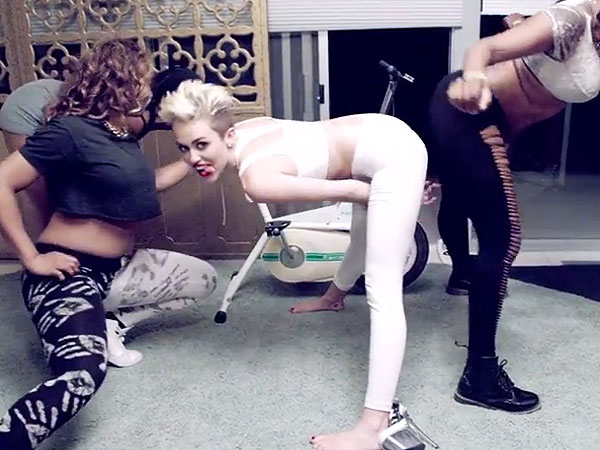
Budding misinformed non-conformist, Miley Cyrus has a couple of important messages in her music video for really slow moving party anthem, “We Can’t Stop.” Most of them involve how they’re not going to shut down the partae, no matter what you squares say! The rest of the video is basically a visual assault of a privileged, rich, white girl using stereotypical elements of a culture associated with lower socio-econonomic classes of minorities, more specifically Black and Latinos to help make herself seem ‘edgy’ and ‘cool.’ There are scenes where she is popping in a gold grill, throwing up non-gang signs while wearing a beanie and a gold chain and of course, her version of twerk-lite with a group of black friends.
Most of the revelers at the party are white, the house they’re in is white, Miley is dressed in all white for most of the video, and there are even scenes of white guys sleeping in piles of white bread. Is there a metaphor to all this? Probably not (other than to make it look like an Urban Outfitters commercial), but the fact that there are only a handful of black friends at the party, most of whom are used as props for the twerking scene and to be the guy who steps in and nods while she sings the lyric “to all my homegirls here with a big butt, shaking it like we at a strip club.” I guess they’re there to say, hey you guys, this isn’t racist cultural appropriation. This is just a MILAE PARTAE! Dear Miley, you are playing at being a member of a certain marginalized group of minorities like it’s dress-up. There is no way you understand what it is like to be marginalized because as a white, rich person you are not. At the end of the day, you can take that grill off and go to your home in the Hollywood hills. Twitter user, Mixed Girl Problems said it best:
Miley sticks middle finger up in pics, smokes & wears grills = just her being a kid. Trayvon does it = hes a thug #SolidarityIsForWhiteWomen
— Mixed Girl Problems (@mixdgrlproblems) August 12, 2013
2. Lady Gaga’s Sexy Burqa Song
There is a special level of awkward reserved for not only appropriating another culture, but appropriating their religious symbols without having a full understanding of their meaning and history. This cringe-inducing moment was reserved this summer for well-intentioned, but often off her allyship-game, pop singer, Lady Gaga, whose alleged single, “Burqa” or possibly titled, “Aura” was leaked online. The song, along with her recent attempts at starting a trend she called ‘burqa swag’ of wearing non-traditional versions of the traditionally Muslim garment out and about, really just goes to show her overall misunderstanding of the practice as a whole. While seen largely in Western culture as an oppressive form of female disempowerment, many Muslim women wear the burqa, or more commonly in the United States, the hijab, as a form of owning their sexuality and their bodies by not allowing themselves to be visually defined or characterized by these things. Without bothering to fully research or attempt to understand this, Gaga presents the burqa as a form of repression in a country that often correlates female empowerment with female sexuality. With lyrics like, “Do you wanna see me naked, lover? Do you wanna peak underneath the cover?” purposefully meant to sexualize a garment whose sole purpose is to avoid such characterizations is not only ignorant, but harmful. As a larger-than-life pop star whose influence spans the globe, spreading misinformation about a practice largely misunderstood by non-Muslims is not only shitty, it’s destructive.
1. Johnny Depp Cast as Tonto

In a Hollywood landscape of western films and television series being churned out left and right in the 40’s, with studios often using whites, Italians or sometimes Latinos to portray Native Americans, Canadian actor and stuntman, Jay Silverheels, a full-blooded Mohawk Native, began portraying the now iconic Indian sidekick and Potowatomi tribesman, Tonto, on the television series, The Lone Ranger (1949-1957). Of course, Tonto was a stereotypical stoic Native stereotype, who basically played supporting character to the white hero, but nonetheless, having a Native character portrayed by a Native actor at the time was a really big deal and a historic moment of Native portrayal in cinema. In 2013, the Disney corporation decided to introduce these western heroes to audiences once again, but this time packaged with young white actor, Armie Hammer in the role of the Lone Ranger and wild-haired white actor, Johnny Depp in the role of Tonto. Yes. Hollywood was able to cast an actual Native person as Tonto in 1949, but not in 2013. Now you know why this made my number one spot.
